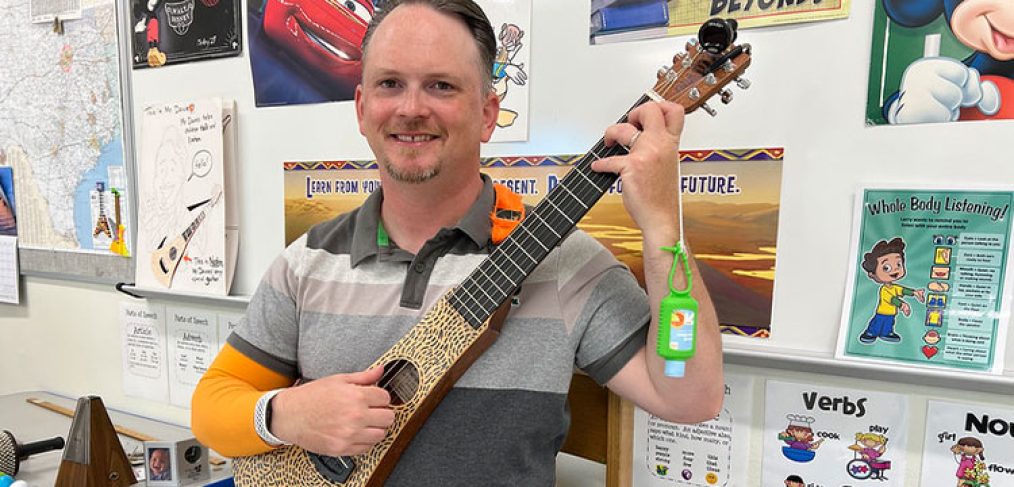
Channeling speech therapy through music
Rees Davies never would have guessed that he would become a speech-language pathologist at Charles A. Gill Elementary School when he was starting his career, but now he would not have it any other way. With his trusty speech therapy guitar, Nadine, in hand, Davies is passionate about transforming student lives every day.
“In grad school they told me, ‘An SLP can take a paperclip and make an activity out of it,’ and that is definitely true with Nadine,” Davies said. “Everything is an activity, and it’s motivating for my students because it’s musical. They want to keep the beat and be a part of it.”
Nadine—who was named after a Chuck Berry song—has her own language, with chords representing everything from basic emotions to colors and phrases. Many of the students Davies encounters struggle with conversations and turn taking, so Davies often “talks” with Nadine to model communication, asking her questions and having her respond with different notes.
While Nadine is a constant in Davies’ practice now, he never could have predicted where he would end up when he graduated from Booker T. Washington High School for the Performing and Visual Arts in 1996 with a speciality in guitar. After several years of teaching music and playing in theaters and bands, the recession of 2008 hit, and Davies started looking for alternative paths. His wife suggested speech-language pathology, and Davies decided to apply for an SLP program with a goal of working in a public school district.
By 2015, Davies completed his SLP program, found a new home campus at Gill and began doing traditional speech therapy. Still, he said he felt like something was missing… until he picked up his guitar again and realized he could incorporate music more heavily into his therapy practice.
Davies found that his traditional guitar was too large to carry around, so he began bringing his smaller “backpacker” guitar instead. That’s how Nadine became a staple of his work.
Today, his students get the opportunity to practice articulating, following instructions, making auditory associations and recognizing emotions in fun ways—all by listening to Nadine’s instructions and following Davies’ cues during activities.
Davies meets with anywhere from three to six groups of up to six students a day, and he said the impact of their time together is “inestimable.” Not only has he cheered on countless students as they pronounced their names correctly for the first time, but he has also helped students go from speaking one word in first grade to putting full sentences together and doing well in classroom settings by fourth grade.
While there is always more work to be done, Davies said he loves what he does and cannot see himself working anywhere else. After all, the need for student support is great, yet the impact is even greater.
“Every student has something important to say, and other people have important things to say back to them,” Davies said. “I always try to get students to buy into that idea—you can change your world by just opening your mouth and saying things. It’s not just for other people; it’s for you.”



